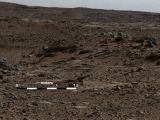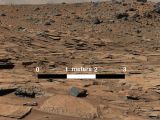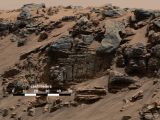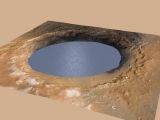Earlier this year, in September, NASA announced that, having reached Mars' Mount sharp, its Curiosity rover was getting ready to explore its anatomy and collect information on how this geological structure came into being.
Recent news on the topic says that, as surprising as this may sound, this Martian mountain started out as a lake. Specifically, NASA scientists say that evidence at hand indicates that it formed from sediments deposited in a lake bed over millions of years.
Mars' Mount sharp is an odd geological structure
In a statement, NASA details that Mount Sharp is located at the center of the Red Planet's Gale Crater. It measures about 3 miles (5 kilometers) in height, which makes it comparable to Earth's Mount Rainier in Washington, US.
It comprised hundreds of rock layers that scientists say are lake, river or wind deposits. This indicates that Mount Sharp formed as a result of a series of fillings and evaporations of a rather large ancient lake that once covered part of the Red planet's surface.
NASA explains that its Curiosity rover is now busy examining the so-called Murray formation, which constitutes the lowest of Mount Sharp's sedimentary layers and which has a height of approximately 500 feet (about 150 meters).
It is believed that this layer that sits at the bottom of the Martian mountain formed from sediments that were carried to the area by rivers flowing into a quite large lake in the Gale Crater. This theory is backed up by geological evidence hinting at the presence of deltas in the region.
“We found sedimentary rocks suggestive of small, ancient deltas stacked on top of one another. Curiosity crossed a boundary from an environment dominated by rivers to an environment dominated by lakes,” said scientist Sanjeev Gupta.
A better understanding of the Red Planet's history
If it is indeed true that Mars' Mount Sharp started out as a lake bed, this means that eons ago the Red Planet was a place warm enough to produce not just transient lakes, but also long-lasting ones. Scientists say that, all things considered, chances are that the planet's atmosphere had a say in the matter.
Thus, it is argued that, but for elevated temperatures that stuck around for several million years, Mars' Gale Crater wouldn't have been able to accommodate for a lake long enough for sediment deposits to jump start the birth of a mountain of its bottom.
“If our hypothesis for Mount Sharp holds up, it challenges the notion that warm and wet conditions were transient, local, or only underground on Mars,” argued researcher Ashwin Vasavada with NASA's Jet Propulsion Laboratory in Pasadena, California.
Scientists expect that, as it continues to explore Mount Sharp and its upper layers, the Curiosity rover will help them better understand how this geological formation came to form on the Red Planet. The rover might even help them figure out whether or not ancient Mars was life-friendly.

 14 DAY TRIAL //
14 DAY TRIAL // 




